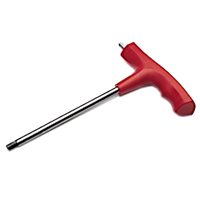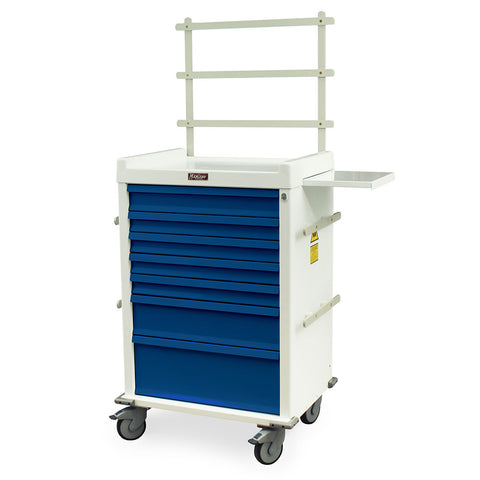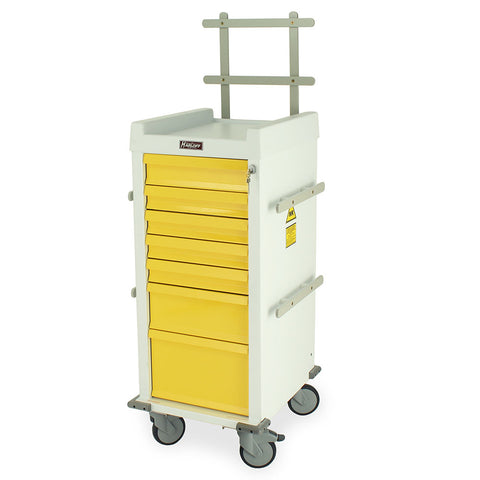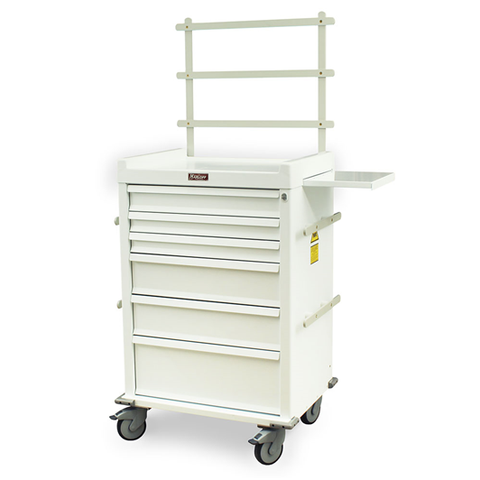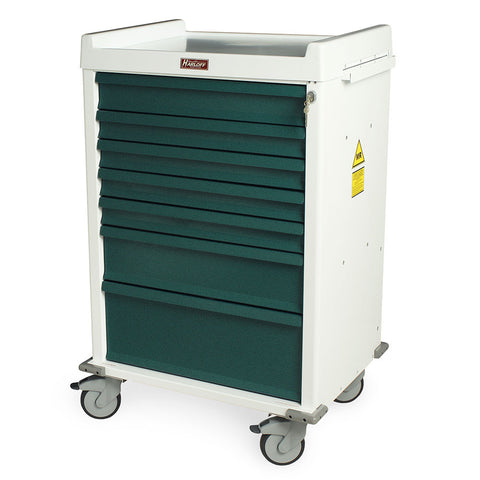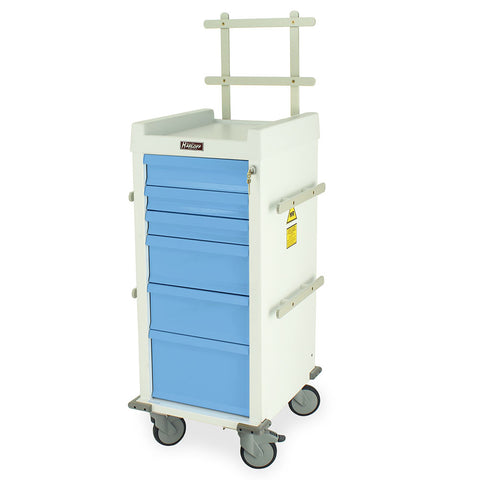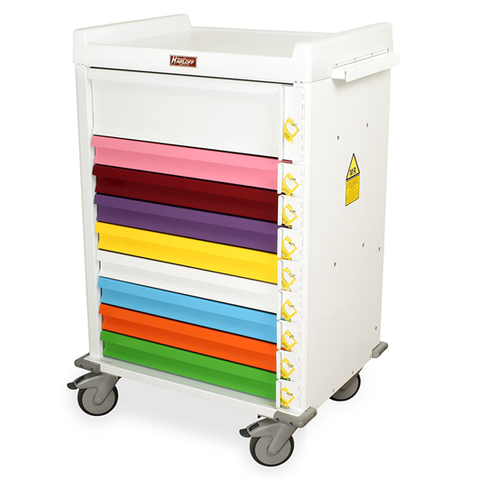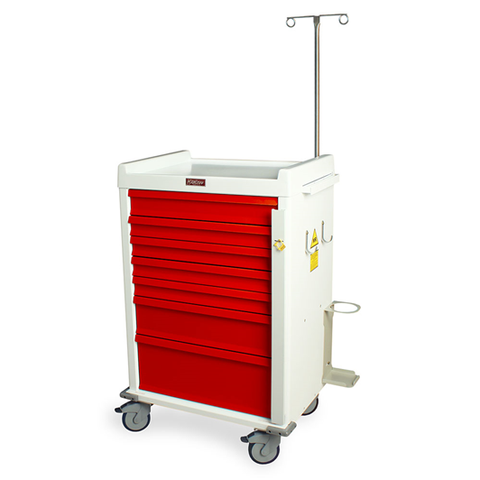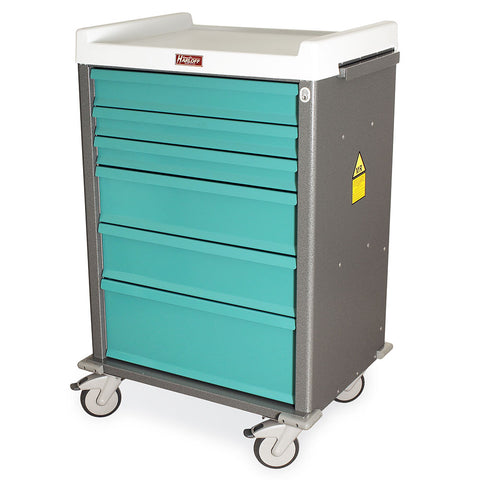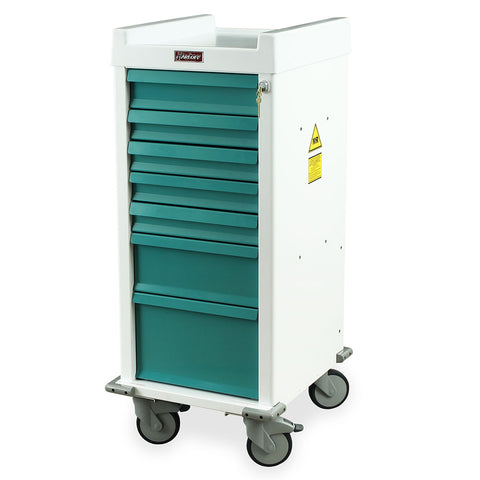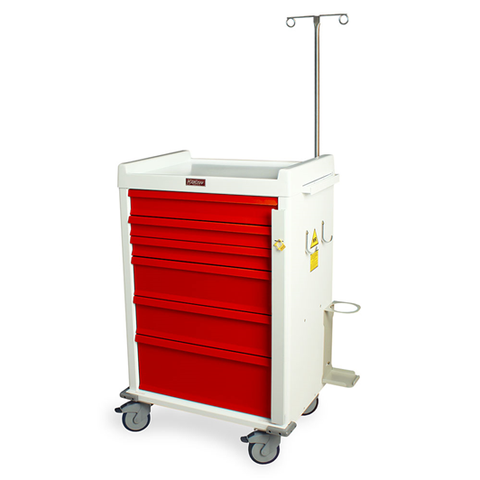MRI is one of the most advanced diagnostic tools available today. However, its powerful magnetic fields can turn unverified medical devices into serious safety hazards. Choosing the right MRI-safe equipment is not just about quality — it’s about compliance with strict safety protocols, protecting staff and patients, and ensuring your facility avoids costly errors.
This guide explains everything you need to know about MRI-safe equipment. You’ll learn how to read safety labels, understand compliance standards, and select products designed specifically for MRI environments — especially for MRI Zone IV, where only the strictest equipment can be used. v
What Is MRI-Safe Equipment?
MRI-safe equipment refers to medical devices, stretchers, wheelchairs, monitoring tools, and other accessories that can be used inside an MRI suite without posing any risk to patients, staff, or the imaging system. MRI-safe products are designed to perform their intended function in the presence of a strong magnetic field without moving, heating, or interfering with image quality.
MRI-Safe vs. MRI-Conditional vs. MRI-Unsafe
According to ASTM F2503, MRI products fall into three categories:
-
MRI-Safe – Items that present no known hazards in any MRI environment. These products are made from completely non-ferromagnetic materials such as aluminum, titanium, and certain polymers. They can be used in all zones, including MRI Zone IV (the magnet room).
-
MRI-Conditional – Items that are safe only under specific conditions, such as a certain magnetic field strength (e.g., 1.5T or 3T), temperature, or orientation. MRI-conditional equipment must include clear labeling and documentation from the manufacturer.
-
MRI-Unsafe – Items that are not safe in any MRI environment. These usually contain ferromagnetic materials that can be attracted to the magnet, creating dangerous projectiles, or they may heat up, cause burns, or distort diagnostic images.
To learn more about how these categories are officially defined, see our related article: “Understanding MRI-Safe, MR-Conditional, and MR-Unsafe Labels.”
Labeling and Manufacturer Requirements
Every product intended for use in MRI environments must be labeled according to ASTM F2503 standards. This includes:
-
A green “MR Safe” icon for products with no known risk.

-
A yellow “MR Conditional” icon with additional text explaining field-strength limits or other conditions.

-
A red “MR Unsafe” icon for items that must never enter an MRI suite.

Manufacturers are required to provide detailed safety documentation, including test results and field strength limitations. Hospitals should never purchase equipment without reviewing these labels and documents first. If there’s any uncertainty about a device, third-party testing should be requested before use.
All MRI equipment on MRI Med is properly labeled to meet current 2025 standards. For example:
-
MRI Non-Magnetic Stretcher – Made from aluminum with zero ferromagnetic components, designed for full MRI safety.
-
MRI Non-Magnetic Wheelchair – Labeled and tested to operate safely in Zone IV.
-
MRI IV Pole – Constructed from stainless steel and aluminum with MR-safe labeling.
To understand how ASTM labeling impacts purchasing decisions, see our related article: “ASTM F2503: What It Means for MRI Equipment Buyers.”
Understanding MRI Zones and Equipment Use
The concept of MRI zones is one of the most critical aspects of MRI safety. Established by the American College of Radiology (ACR), the zone system divides the MRI suite into four distinct areas — Zones 1 through 4 — each with increasing levels of restriction and control. The goal is simple: to prevent accidents caused by ferromagnetic objects entering high-field MRI environments.
Understanding these zones is essential when choosing MRI-safe equipment. The wrong stretcher, wheelchair, or IV pole in the wrong zone can turn into a projectile hazard or compromise image quality. Selecting properly labeled equipment ensures your facility stays compliant and — most importantly — keeps staff and patients safe.
Overview of Zones 1–4
Zone 1 – Public Access Area
This is the general reception area, where no magnetic field is present. Patients, staff, and visitors do not need any special screening here. Most standard hospital furniture and equipment can be used safely. However, you should still avoid introducing ferromagnetic items that may be later wheeled toward higher zones.
Zone 2 – Patient Preparation and Waiting Area
This semi-restricted area is where patients are typically screened and prepped. Only non-magnetic or low-risk items should be introduced here to avoid mistakes later. For example, MRI non-magnetic step stools are ideal for helping patients safely get onto gurneys or examination tables during prep.
Zone 3 – Controlled Access Area
This area is restricted to trained MRI personnel. A powerful fringe magnetic field is already present, which means ferromagnetic objects can become dangerous if brought inside. Only MRI-safe or MRI-conditional equipment with proper documentation should enter Zone 3. Products such as MRI-safe monitoring equipment and non-magnetic oxygen cylinders are suitable here.
Zone 4 – The Magnet Room
Zone 4 houses the MRI scanner itself and requires the strictest safety protocols. The magnet is always on, even when not actively scanning, and any ferromagnetic object can become a dangerous projectile. Only fully MRI-safe equipment with green ASTM labels can be used in this area. Examples include:
-
MRI non-magnetic stretchers — aluminum frame, tested for use directly in Zone 4.
-
MRI-safe wheelchairs — built for transport directly into the magnet room.
-
MRI non-magnetic IV poles — stable and clearly labeled for Zone 4 safety.
To understand how these zones impact equipment labeling, read our related article: “MR Zones 1-4: Equipment Guidelines You Must Know.”
Zone IV Equipment Protocols
Equipment used inside the magnet room must be completely non-ferromagnetic and tested according to ASTM standards. It is not enough to simply assume that “if it’s plastic, it’s safe.” Even small metal components hidden inside a device can pose risks. Hospitals must:
-
Verify ASTM F2503 labeling on every item.
-
Ensure staff training so no unverified equipment enters Zone 4.
-
Keep dedicated Zone 4 stretchers, wheelchairs, and supply carts to avoid accidental swaps with unsafe equipment.
For example, the MRI Non-Magnetic Stretcher from MRI Med is manufactured from lightweight aluminum with no ferromagnetic parts. It can safely remain in Zone 4 at all times. Similarly, MRI-safe anesthesia tables are engineered to operate without creating image artifacts or posing hazards inside high-field MRI rooms.
Why Zone IV Requires the Strictest Standards
Zone 4 is where the full power of the MRI magnet is concentrated. Unlike a CT scanner or X-ray, an MRI magnet is always on. This means:
-
Unsecured ferromagnetic objects can accelerate toward the magnet at high speed, creating “missile events.”
-
Electronic devices that are not MRI-safe can fail or cause burns.
-
Image distortion can occur if inappropriate materials are introduced.
The safest strategy is to keep dedicated MR-safe equipment in Zone 4 at all times. For example:
-
MRI stretchers with locking side rails for safe patient transfer directly into the scanner room.
-
MRI-safe supply carts to organize non-magnetic tools and supplies right where they are needed.
-
MRI monitoring devices that meet ASTM labeling and FDA requirements for use inside the bore.
To better understand how these rules are enforced and why they’re critical, see our related article: “What Hospitals Get Wrong About MRI-Safe Equipment.”.
Compliance Standards You Need to Know
MRI safety is not just a matter of best practices — it’s also governed by formal standards and regulations. Every piece of equipment used in an MRI suite, especially inside Zone IV, must be tested, labeled, and documented according to specific guidelines. Understanding these standards is critical for hospital administrators, radiology staff, and purchasing departments when selecting equipment.
In this section, we’ll explore ASTM standards, FDA guidance, and institutional protocols that ensure your MRI environment remains compliant and safe.
ASTM F2503: The Global Labeling Standard for MRI Equipment
The American Society for Testing and Materials (ASTM) created a universal labeling system — ASTM F2503 — to indicate whether medical devices or hospital equipment are safe for MRI use. You’ll commonly see three labels:
-
MR Safe (green label):
-
Completely non-metallic and non-conductive.
-
Can be used anywhere in the MRI suite, including Zone IV and directly inside the bore.
-
Example: MRI Non-Magnetic Wheelchair — aluminum frame, green-labeled for full safety.
-
MR Conditional (yellow label):
-
Safe only under specific conditions (e.g., certain magnet strengths or locations).
-
Must be used according to the manufacturer’s instructions.
-
Example: MRI Monitoring Equipment — devices tested to work safely at specified Tesla ratings.
-
MR Unsafe (red label):
-
Cannot be used anywhere near MRI magnets.
-
Ferromagnetic or electronic components pose a projectile or interference risk.
Why this matters: Hospitals must verify labeling for every stretcher, IV pole, or anesthesia cart before it enters Zones III or IV.
FDA Guidance for MRI-Conditional Devices
In the United States, the Food and Drug Administration (FDA) regulates medical devices that are used in MRI environments. Manufacturers must provide:
-
Testing data showing compliance with ASTM standards
-
Labeling that specifies safe operating conditions
-
Evidence that devices do not cause image distortion or pose safety risks
FDA guidance applies to everything from MRI patient monitors to anesthesia carts.
Hospitals should keep compliance documentation on file for every piece of MRI equipment. This protects your facility during Joint Commission audits, FDA inspections, or ACR accreditation reviews.
Institutional Protocols and Safety Committees
Even with ASTM and FDA standards in place, each facility is responsible for creating its own MRI safety policies. This usually involves:
-
MRI Safety Committees: Groups of radiologists, physicists, technologists, and administrators who approve every new device before it’s used in Zone IV.
-
Equipment Audit Logs: Records of when devices are purchased, tested, and verified as MRI-safe.
-
Annual Training Programs: Ensuring staff know how to read labels, identify unsafe items, and handle emergencies.
For instance, a hospital might maintain dedicated MRI supply carts stocked only with MRI non-magnetic tools and accessories to avoid mix-ups with standard hospital equipment.
These institutional safeguards reduce the risk of human error, ensuring that only properly labeled equipment enters the MRI suite.
How to Evaluate MRI-Safe Equipment Before Buying
Purchasing MRI-safe equipment requires more than selecting the first product labeled “plastic” or “non-magnetic.” Healthcare facilities must follow a rigorous evaluation process to ensure safety, compliance, and operational efficiency. MRI rooms, particularly Zone IV, present unique challenges due to the strong magnetic fields. Using uncertified or inadequately tested equipment can result in injuries, equipment damage, and compromised imaging quality.
Evaluating MRI-safe equipment before purchase involves reviewing certification documentation, asking the right questions, and verifying third-party testing. Each step helps healthcare buyers make informed decisions, reduce liability, and streamline MRI suite operations.
Certification Documentation
Certification documentation is the primary evidence that an MRI device is safe for use in specific zones. It provides details about the device’s material composition, field strength limits, and manufacturer testing protocols. When reviewing documentation, pay attention to:
-
ASTM F2503 labeling – The document should clearly indicate if a device is MR Safe, MR Conditional, or MR Unsafe. This standard ensures consistency in safety labeling across all MRI equipment.
-
Field strength specifications – MR Conditional devices may be safe only under certain magnetic field strengths (e.g., 1.5T or 3T). Documentation should include these limitations.
-
Zone placement guidance – High-risk areas like Zone IV require precise instructions about which devices are allowed and under what conditions.
Equip Your Team with Tools They Can Trust
Get high-quality, MRI-dedicated equipment that supports safer scans, better positioning, and smoother patient care.
View Trusted Products
Practical tip: MRIMed provides comprehensive certification documentation with every MRI stretcher, wheelchair, and IV pole. These documents simplify audits and ensure compliance with ASTM and FDA guidelines. Explore MRI-Conditional stretchers.
Ask These Questions Before Purchasing
Asking the right questions helps verify that equipment is truly MRI-safe and suitable for your facility’s workflow. Buyers should ask vendors:
-
Has this device been tested in MRI environments?
-
Request test reports demonstrating performance in real MRI conditions.
-
Is this device MR Safe or MR Conditional, and under what field strengths?
-
Avoid assumptions; labeling alone may not reflect real usage conditions.
-
What materials are used in construction?
-
Ensure no hidden ferrous metals are present, including in wheels, fasteners, or hinges.
-
Is there manufacturer or third-party verification?
-
Independent testing ensures unbiased confirmation of safety.
-
Are maintenance guidelines included for Zone IV use?
-
Proper upkeep extends device lifespan and preserves MRI safety.
Third-Party Testing and Validation
Relying solely on manufacturer claims can be risky. Third-party testing provides independent validation of MRI safety. Certified labs or testing organizations examine:
-
Material magnetic properties – Detects ferrous metals or alloys.
-
Device performance under MRI fields – Ensures mechanical integrity, movement safety, and imaging quality.
-
Label accuracy – Confirms MR Safe or MR Conditional classifications.
Why it matters:
Even small ferromagnetic components can create projectile hazards, heat buildup, or imaging artifacts. Third-party testing eliminates uncertainty, providing objective proof of safety.
Evaluating MRI-safe equipment through these steps protects patients, staff, and imaging integrity, while also helping facilities meet regulatory standards and streamline MRI suite operations.
Common Mistakes in MRI Equipment Selection
Selecting MRI-safe equipment might seem straightforward, but healthcare facilities often make avoidable mistakes that compromise patient safety, staff safety, and imaging quality. These errors can be costly, both in terms of compliance and liability. Understanding these mistakes helps radiology departments make better-informed decisions and ensure every device in MRI Zone IV is truly safe.
Overlooking Compliance
One of the most frequent mistakes in MRI equipment selection is failing to verify compliance with recognized standards. MRI suites operate under strict safety regulations, and ignoring these can result in accidents or audit failures.
Why compliance matters:
-
ASTM F2503 standards define labeling for MR Safe, MR Conditional, and MR Unsafe equipment. Without adherence to these standards, items may pose hidden hazards.
-
FDA guidelines provide additional regulatory oversight for medical devices in MRI environments. Using equipment without proper FDA recognition can put both patients and staff at risk.
-
Hospitals that overlook compliance may assume that any modern medical device is safe, but even small metallic components can cause projectile hazards in MRI rooms.
Real-world example:
Many facilities attempt to bring older wheelchairs or IV stands into Zone IV, assuming they are safe because they appear “modern” or plastic-coated. These items may have internal ferrous components that could be pulled into the magnet, creating life-threatening injuries or damaging the scanner.
Solution:
-
Always check for ASTM-labeled MR Safe or MR Conditional equipment.
-
Verify that documentation is complete and up-to-date.
-
Purchasing from MRI Med ensures every item meets ASTM and FDA standards, removing the guesswork.
Assuming “Plastic” = MRI-Safe
Another common misconception is assuming plastic equipment is automatically safe for MRI use. While plastic is non-ferrous and generally safe, most hospital devices contain a mix of materials, including hidden metal fasteners, screws, or internal mechanisms.
Why this assumption is risky:
-
Non-visible ferrous materials can act as projectiles when exposed to MRI fields.
-
Plastic-coated items may still contain aluminum, steel, or iron frames inside.
-
Devices that seem harmless can distort images or create heating hazards, affecting scan quality.
Example:
-
An IV pole with a plastic exterior might have steel springs or joints inside.
-
A “plastic” stretcher may have metal hinges or locking mechanisms that can move unexpectedly in a magnetic field.
Solution:
-
Verify the entire construction of any device, not just the outer surface.
-
Only use equipment with full MR Safe or MR Conditional testing documentation, such as MRI stretchers, wheelchairs, and IV poles from MRIequip.com.
Not Verifying Zone Appropriateness
MRI safety zones are strictly defined from Zone I to Zone IV, with Zone IV being the scanner room where the magnetic field is strongest. Failing to verify whether equipment is permitted in a specific zone is a serious error.
Common pitfalls:
-
Using devices labeled MR Conditional in Zone IV without checking their specific field strength limits.
-
Moving equipment from storage areas (Zone III) into Zone IV without proper verification.
-
Assuming items labeled MR Safe can be used at all MRI field strengths.
Why it matters:
-
Zone IV has the highest magnetic field intensity, so even small errors can lead to projectile accidents, patient injuries, or scanner damage.
-
Incorrectly deployed devices can invalidate imaging results, resulting in repeat scans and increased costs.
Solution:
-
Check ASTM and manufacturer specifications for each item.
-
Follow zone-specific protocols for every MR Safe or MR Conditional device.
-
MRIequip.com products include clear zone placement guidance, ensuring each item is used safely in the correct area.
Summary of Key Takeaways for Mistakes:
-
Compliance cannot be assumed – always verify standards.
-
Plastic does not guarantee safety – inspect for hidden metals.
-
Zones must be respected – check MR Conditional specifications carefully.
-
Use certified vendors – eliminates guesswork and reduces liability.
By avoiding these mistakes, healthcare facilities can protect patients, safeguard staff, maintain compliance, and improve imaging quality.
FAQ:
1. How can I tell if a device is non-ferromagnetic?
Check the ASTM F2503 label and confirm the materials are aluminum, titanium, or approved plastics.
2. Are all aluminum or plastic devices safe in MRI suites?
No, only devices tested and certified for MRI use are safe.
3. How often should non-ferromagnetic devices be tested?
At least once a year or following the manufacturer’s instructions.
4. Can non-ferromagnetic devices interfere with MRI scans?
Properly tested devices do not affect image quality.
5. Why is it important to buy from trusted suppliers like MRIMed?
Trusted suppliers provide tested devices, proper documentation, and ensure MRI safety.
Related Articles
